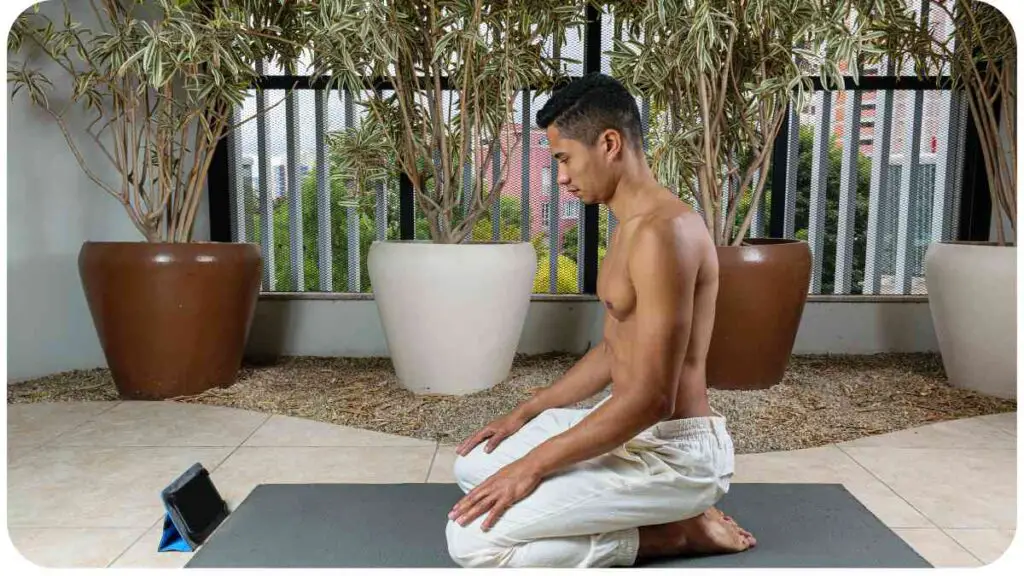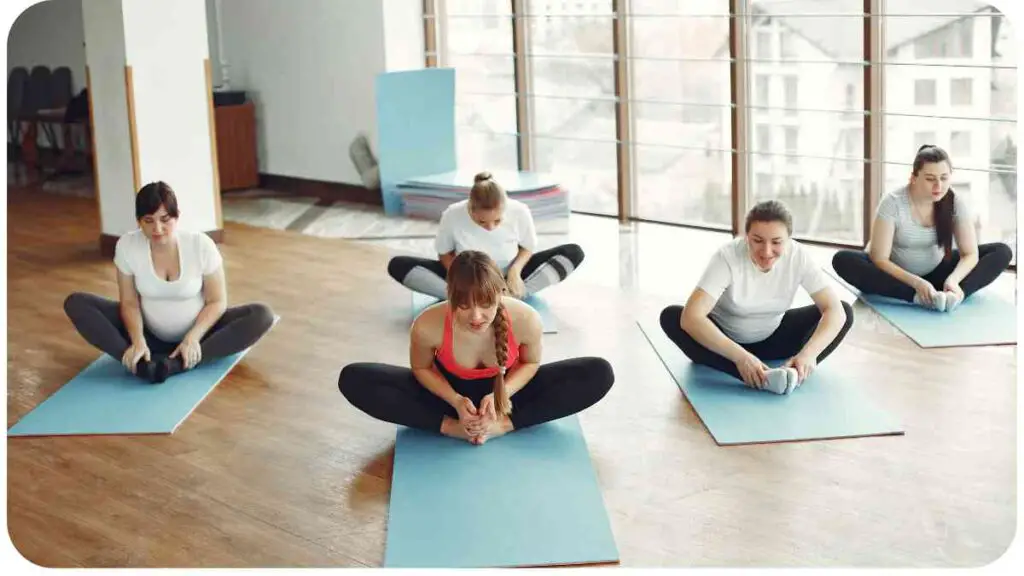Welcome to this quick and easy guide on using yoga for grief relief. Losing someone dear to us or experiencing a significant loss can be an incredibly challenging and painful experience. Grief affects us physically, emotionally, and mentally, but fortunately, yoga can provide a potent tool for healing and finding solace.
In this article, we will delve into the profound benefits of using yoga as a means of navigating the grieving process. We will explore various yoga poses, breathwork techniques, and meditation practices specifically tailored to help you find relief and comfort during this difficult time. Through personal anecdotes and professional expertise, we aim to provide you with actionable advice and valuable insights.
Let’s embark on this journey together, embracing the healing power of yoga and discovering how it can support you on your path to grief relief.
| Takeaway |
| Yoga can be a helpful practice for individuals navigating the grieving process. |
| Incorporating yoga into your routine can bring emotional relief and reduce stress. |
| Deep breathing techniques and meditation can enhance the benefits of yoga for grief relief. |
| Choosing gentle and nurturing yoga poses can provide comfort and promote healing. |
| Regular yoga practice can cultivate resilience and support overall well-being during grief. |
| Yoga should be complemented with other supportive practices, such as therapy or support groups. |
| Self-care practices and self-compassion are essential components of a grief-focused yoga journey. |
2. Understanding Grief
What is Grief?
Grief is a natural and complex human response to loss. It can occur when we experience the death of a loved one, the end of a significant relationship, the loss of a job, or even the disruption of life due to a major change. Grief encompasses a range of emotions, including sadness, anger, guilt, and confusion. It is a deeply personal and unique experience, as each individual grieves in their own way and at their own pace.
Yoga and exercise can both effectively relieve grief through movement and breathwork. Regular physical activity provides an natural outlet to release pent up emotions and focus on self care goals that promote healing through distraction when mourning. Exercise tips can aid in processing trauma and recovery from loss.
The Stages of Grief

Grief often follows a non-linear path and is commonly associated with the five stages of grief proposed by psychiatrist Elisabeth Kübler-Ross: denial, anger, bargaining, depression, and acceptance. It’s essential to recognize that these stages are not necessarily sequential, and individuals may experience them in varying degrees or order.
Throughout this guide, we will explore how yoga can help you navigate these stages by providing physical, emotional, and psychological support. So let’s move forward and discover the remarkable benefits of yoga for grief relief.
3. Exploring the Benefits of Yoga for Grief Relief
Yoga offers a holistic approach to grief relief, addressing not only the physical symptoms but also the emotional and psychological aspects of grieving. By incorporating yoga into your life, you can experience numerous benefits that aid the healing process. Let’s take a closer look at the physical, emotional, and psychological benefits of practicing yoga for grief relief.
Self care practices like meditation, yoga, and mindfulness meditation encourage relaxing the body and calm the racing thoughts and worries that accompany grief. Making time for self care techniques nourishes both body and soul which is critical for long term emotional wellbeing despite immense sadness.
Physical Benefits
TABLE: Physical Benefits of Yoga for Grief Relief
| Benefit | Description |
| Improved Flexibility | Yoga poses gently stretch the body, enhancing mobility and reducing muscle tension. |
| Relieved Tension | Yoga practices focus on releasing physical tension, promoting relaxation and comfort. |
| Enhanced Energy Flow | Practicing yoga stimulates the flow of energy throughout the body, revitalizing the system. |
| Better Sleep | Regular yoga practice can improve sleep quality, helping you find rest during times of grief. |
Emotional Benefits
TABLE: Emotional Benefits of Yoga for Grief Relief
| Benefit | Description |
| Reduced Anxiety | Yoga promotes deep breathing and relaxation, helping to alleviate anxiety and calm the mind. |
| Enhanced Mood | The mindful movement and focus in yoga can uplift your mood and bring emotional balance. |
| Increased Self-Awareness | By cultivating self-awareness through yoga, you can better understand and process your emotions. |
| Stress Reduction | Yoga offers effective stress management techniques that can help you cope with grief-related stress. |
Psychological Benefits
TABLE: Psychological Benefits of Yoga for Grief Relief
| Benefit | Description |
| Improved Mental Clarity | Regular yoga practice enhances mental clarity and focus, allowing you to better navigate the grieving process. |
| Enhanced Resilience | Yoga helps in developing resilience, enabling you to face challenging emotions and experiences with strength. |
| Increased Mindfulness | The mindfulness aspect of yoga cultivates present-moment awareness, enhancing your ability to cope with grief. |
| Reduced Depression | Practicing yoga releases endorphins and promotes positive emotions, potentially reducing symptoms of depression. |
Now that we have explored the various benefits of practicing yoga for grief relief, let’s move on to the next step: getting started with yoga.
Adopting daily mindfulness routines is challenging but aids significantly in processing intense emotions through non judgement. Many find using mindfulness techniques grounds them in the present moment instead of becoming overwhelmed by flashbacks and rumination about what could have been.
4. Getting Started with Yoga

To effectively use yoga for grief relief, it’s important to approach it with intention and create a supportive environment for your practice. Here are some essential considerations to help you get started:
Finding a Suitable Yoga Style
When starting your yoga journey, it’s crucial to choose a yoga style that aligns with your needs and preferences. Some styles that can be beneficial for grief relief include Hatha yoga, Yin yoga, and Restorative yoga. These styles emphasize gentle and nurturing practices that promote relaxation, flexibility, and inner peace.
Choosing a Yoga Instructor
To ensure a safe and effective practice, it’s recommended to find a knowledgeable and experienced yoga instructor who specializes in working with individuals experiencing grief. Look for instructors who prioritize compassion, empathy, and understanding. A qualified instructor can guide you through your yoga practice with sensitivity and provide modifications as needed.
Creating a Safe and Comforting Space
Designate a specific area in your home that serves as your yoga space. Clear the area of any clutter or distractions, and make it comfortable with props such as blankets, bolsters, and yoga mats. Add elements that bring you solace, such as candles, essential oils, or serene artwork. This space will be your sanctuary for practicing yoga and finding solace during your grieving process.
Now that you have set the groundwork for your yoga practice, let’s explore some specific yoga poses that can provide grief relief.
Grieving typically feels like an isolating experience but incorporating consistent self care activities helps process trauma, honor the loved one and realize we’re not alone. Small steps nurturing body and soul pave the path towards finding peace again.
5. Yoga Poses for Grief Relief
TABLE: Yoga Poses for Grief Relief
| Pose | Description |
| Mountain Pose (Tadasana) | This foundational pose invokes a sense of stability and strength, grounding you in the present moment. |
| Child’s Pose (Balasana) | Child’s pose offers a comforting position that allows you to surrender and release any tension or emotions held within. |
| Forward Fold (Uttanasana) | This gentle forward bend helps to calm the mind, relieve anxiety, and release tension in the back and hamstrings. |
| Bridge Pose (Setu Bandhasana) | The bridge pose opens the heart and chest, promoting feelings of love, compassion, and emotional release. |
| Legs-Up-the-Wall Pose (Viparita Karani) | This restorative pose helps to alleviate fatigue, reduce anxiety, and promote a sense of relaxation and rejuvenation. |
Now that we have explored some beneficial yoga poses for grief relief, let’s continue our journey by incorporating breathwork and meditation as additional tools for healing.
6. Incorporating Breathwork and Meditation
Breathwork and meditation are powerful techniques that can deepen your yoga practice and provide profound relief during times of grief. Let’s delve into the practices you can incorporate:
Deep Breathing Techniques
Deep breathing is an essential component of yoga and can be used as a powerful tool for stress reduction and emotional regulation. One technique you can try is the “4-7-8” breath: inhale deeply for a count of 4, hold the breath for a count of 7, and exhale slowly for a count of 8. This technique allows you to activate the body’s relaxation response and release tension.
Guided Meditations for Grief Relief
Meditation provides an opportunity to cultivate inner stillness, acceptance, and self-compassion. Guided meditations specifically designed for grief can help you process emotions, find solace, and nurture healing. You can access guided meditation resources online or through meditation apps, selecting ones that align with your specific needs.
As you incorporate breathwork and meditation into your yoga practice, you will deepen your connection to yourself and discover new ways to navigate your grief journey.
Simple techniques like breathing exercises or guided mindfulness techniques can shift painful ruminating thoughts. Making space for grief in a compassionate way is healing for both mind and heart even in darkest of times.
7. Establishing a Regular Yoga Practice
To experience the full benefits of yoga for grief relief, it’s important to establish a regular practice. Here are some tips to help you maintain consistency:
Setting Realistic Goals
Start with small, attainable goals that fit your current circumstances. Aim to practice yoga for a few minutes each day or a specific number of times per week. By setting achievable goals, you are more likely to stay committed and experience gradual progress.
Creating a Routine
Incorporate yoga into your daily or weekly routine. Choose specific times that work best for you, whether it’s in the morning to start your day with a centered mindset or in the evening to wind down and release any accumulated tension.
Overcoming Barriers and Challenges
Understand that there may be days when you feel resistant to practicing yoga, especially during times of intense grief. In such moments, remind yourself of the benefits and use gentle strategies to motivate yourself. Encourage yourself with self-compassion and allow flexibility in your practice.
By establishing a consistent yoga practice, you will cultivate resilience and find solace amidst the challenges of grief.
8. Complementing Yoga with Supportive Practices

While yoga can be an incredibly beneficial practice for grief relief, it’s important to remember that it can be complemented by other supportive practices. Here are some additional practices to consider:
Seeking Professional Help
If you find that your grief is impacting your daily life significantly, consider reaching out to a therapist or counselor experienced in grief counseling. They can provide additional support, guidance, and specific therapeutic techniques to help you navigate your unique grief journey.
Journaling and Reflecting
Engage in journaling as a means of self-expression and reflection. Write down your thoughts, emotions, and experiences related to grief and your yoga practice. This process can bring clarity, insights, and facilitate the release of emotions. Reflect on your personal growth and any transformative experiences you encounter along the way.
Connecting with Support Groups
Joining a support group or community of individuals who have also experienced loss can provide valuable empathy, understanding, and a sense of belonging. Engaging in discussions and sharing experiences can offer comfort and reassurance that you are not alone in your grief.
Nurturing Self-Care Practices
Incorporate self-care practices that nourish your mind, body, and soul. This can include activities such as taking relaxing baths, spending time in nature, practicing mindfulness outside of yoga, or engaging in hobbies that bring you joy and tranquility. Remember to prioritize self-care throughout your grief journey.
These supportive practices can work synergistically with yoga to provide a comprehensive approach to grief relief.
Frequently Asked Questions (FAQs)
Can yoga really help in overcoming grief?
Yes, yoga can be a powerful tool for navigating the grieving process. It addresses the physical, emotional, and psychological aspects of grief, providing relief, healing, and a greater sense of resilience. Yoga offers a safe and nurturing space to process emotions, reduce stress, and cultivate self-awareness.
How often should I practice yoga for grief relief?
The frequency of practice depends on your personal preferences and circumstances. Start with a realistic and attainable goal, such as a few minutes each day or a few times per week. Consistency is key, so choose a frequency that you can commit to. Regular practice will help you experience the cumulative benefits of yoga for grief relief.
Can I practice yoga if I am new to it or not flexible?
Absolutely! Yoga is a practice that can be modified and adapted to suit individual needs and abilities. There are variations and props available for every pose, allowing you to practice at your own pace and level. Remember, yoga is not about achieving perfect flexibility or poses but about cultivating self-acceptance and honoring your body’s needs.
Are there any specific poses that should be avoided during grief?
While individual preferences may vary, it’s generally recommended to avoid intense or physically demanding poses that can generate additional stress or overwhelm. Listen to your body and choose poses that feel nurturing, calming, and grounding. The poses mentioned in this guide, such as Child’s Pose and Legs-Up-the-Wall Pose, are generally safe and beneficial for grief relief.
10. Conclusion
Using yoga for grief relief can be a transformative and healing practice. It offers physical, emotional, and psychological benefits that support you through the grieving process. By incorporating yoga poses, breathwork techniques, and meditation practices, you can find solace, resilience, and inner peace during challenging times.
Remember, everyone’s grief journey is unique, and it’s important to honor and give yourself grace throughout the process. Seek support when needed, whether from a yoga instructor, therapist, or support group. Embrace yoga as a gentle companion on your path to healing, and may it provide you with the strength and balance you need to navigate grief with compassion and self-care.
Further Reading
Yoga and Grief: A Path to Healing
This article explores the connection between yoga, grief, and meditation. It provides insights into how yoga can help individuals process grief and offers practical techniques for incorporating yoga into a healing journey.
Yoga for Grief Relief
In this book, author Antonio Sausys combines his expertise in yoga therapy and grief counseling to provide a comprehensive guide to using yoga for grief relief. It offers gentle yoga practices, breathwork, and meditation techniques specifically tailored for individuals navigating the grief journey.
Yoga for Grief Relief: Simple Practices for Transforming Your Grieving Mind and Body
Written by Antonio Sausys, this book offers a range of yoga practices and mindfulness exercises designed to support individuals dealing with grief. It provides step-by-step instructions and an exploration of the mind-body connection in relation to grief.
FAQs
How can yoga help with the grieving process?
Yoga can help with the grieving process by providing physical and emotional relief, reducing anxiety and stress, promoting self-awareness, and enhancing resilience.
Is yoga suitable for beginners or those who are not flexible?
Yes, yoga is suitable for beginners and individuals with varying levels of flexibility. Yoga can be modified to accommodate different abilities and needs. It’s about honoring and accepting your body as it is.
How often should I practice yoga for grief relief?
The frequency of practice depends on your personal preferences and circumstances. Start with a realistic goal and be consistent. Whether it’s a few minutes each day or several times a week, regular practice can offer cumulative benefits.
Are there specific poses to avoid during grief?
While preferences may vary, it’s generally recommended to avoid intense or physically demanding poses that may cause additional stress. Focus on gentle, nurturing poses and listen to your body’s needs.
Can yoga alone heal grief?
Yoga can be a powerful tool for healing grief, but it’s important to remember that everyone’s journey is unique. Yoga can complement other forms of support, such as therapy and support groups, providing a holistic approach to healing.

My name is Hellen James. I’m a grief and loss recovery expert who has helped people across the country to move beyond their grief and move forward with their lives.


